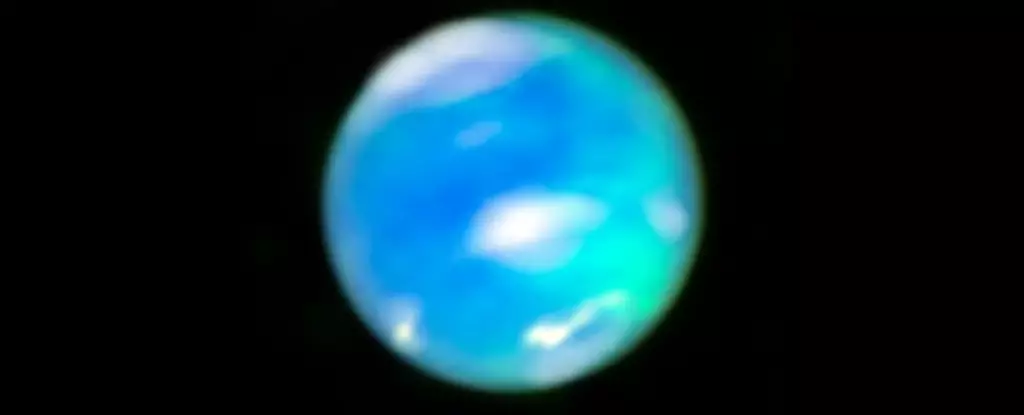Neptune, the enigmatic azure giant of our Solar System, has long tantalized astronomers with its elusive atmosphere and swirling storms. Earlier this year, however, a breakthrough came thanks to the James Webb Space Telescope (JWST), which captured a stunning representation of Neptune’s auroras for the very first time. This revelation isn’t just a dazzling image; it’s a pivotal moment in our understanding of planetary science and the broader implications for how celestial bodies interact with solar winds.
Neptune resides far beyond the grip of the Sun at a staggering 30 times the distance of Earth, making it a challenging subject for study. Its remote position means that the delicate phenomena such as auroras might be more subdued compared to the vibrant displays witnessed on Earth, Jupiter, and Saturn. Astrobiologists and astronomers have long wondered what kind of auroras, if any, could be elicited by such a distant star, leading to this groundbreaking moment when JWST unveiled the subtle infrared glow of Neptune’s auroras.
Uncharted Territory: Beyond Auroras on Earth
The auroras of various planets provide a compelling tapestry of how celestial bodies respond to radiation from their respective stars. On Earth, auroras manifest in a kaleidoscope of colors—green, red, and sometimes even purple—when charged particles from the solar wind collide with our atmosphere. Jupiter’s auroras, on the other hand, possess an astounding intensity, emitting bright ultraviolet light that can even be observed from space. The existence of auroras on these planets illustrates the intricate relationship between celestial bodies and their magnetic fields—an interaction that is perhaps even more intricate in the outer Solar System.
Neptune’s auroras, however, reveal a unique twist: their positioning near the planet’s equator rather than at the poles. This unusual phenomenon stems from Neptune’s chaotic magnetic field, which deviates from the typical patterns we observe on Earth. Such findings force us to rethink our assumptions about planetary dynamics and how they manifest at different distances from the Sun. The revelation that Neptune shares this characteristic with Uranus only deepens the intrigue surrounding these ice giants.
The Science Behind the Spectacle
Using the advanced capabilities of JWST, astronomers led by Henrik Melin of Northumbria University were able to detect the trihydrogen cation (H3+), a molecular fingerprint indicating the presence of auroras. This discovery underscores the transformative power of modern technology in astronomy, as it allows us to peel back layers of mystery surrounding distant planets. The spectrum collected by JWST revealed not just the presence of auroras but provided a more nuanced understanding of the temperature dynamics at play on Neptune.
Interestingly, JWST measured significantly lower temperatures than those recorded during Voyager 2’s historic flyby in 1989. This cooling, possibly a consequence of Neptune’s changing atmosphere over decades, has inadvertently masked the auroral activity. Lower temperatures translate to fainter auroras, which could explain why previous searches had failed to yield tangible evidence of these astronomical manifestations. The calibration of observational techniques and the advent of sophisticated tools like JWST now opens up new avenues for exploring the outer Solar System’s phenomena.
A Broader Implication on Exoplanet Studies
One of the most exciting aspects of this discovery extends beyond Neptune itself; it enhances our ability to comprehend planetary atmospheres on exoplanets orbiting distant stars. As we gain insights into how different planetary environments generate auroras, we can refine our models for studying potentially habitable exoplanets. By drawing parallels between the auroral phenomena we observe in our Solar System and those that might exist elsewhere, we gear up for a fresh exploration of the cosmos.
Neptune’s recently unveiled auroras serve as both a scientific achievement and a reminder of the adventure that awaits in unraveling the mysteries of our universe. Each new discovery reaffirms the idea that every planet has its own story to tell, contributing to the grand narrative of cosmic exploration. As we continue to develop increasingly refined technologies, the sky, or indeed the entire universe, may no longer be the limit.


Leave a Reply